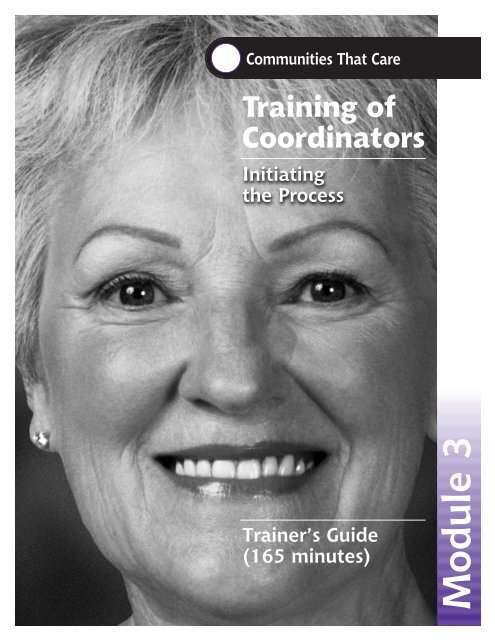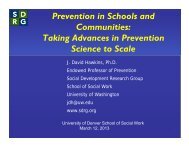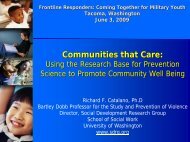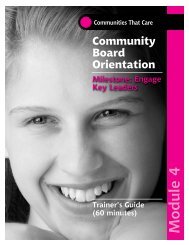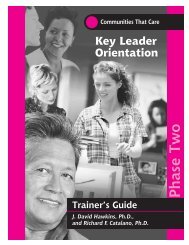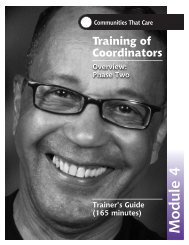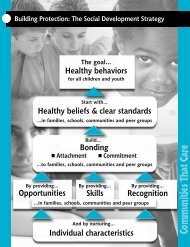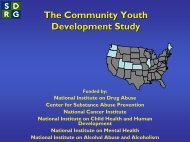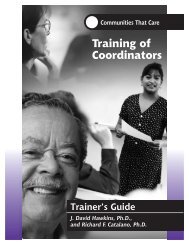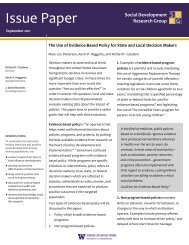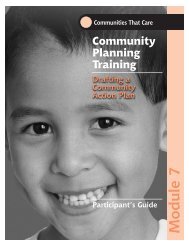TOC Training Guide Module 3
TOC Training Guide Module 3
TOC Training Guide Module 3
You also want an ePaper? Increase the reach of your titles
YUMPU automatically turns print PDFs into web optimized ePapers that Google loves.
Communities That Care<br />
<strong>Training</strong> of<br />
Coordinators<br />
Initiating<br />
the Process<br />
Trainer’s <strong>Guide</strong><br />
(165 minutes)<br />
<strong>Module</strong> 3
Slides for <strong>Module</strong> 3<br />
<strong>Module</strong> 3......................................................................... 3-1<br />
<strong>Module</strong> 3 goal................................................................. 3-2<br />
Objectives ....................................................................... 3-3<br />
Qualities, skills and expertise<br />
of a Coordinator.............................................................. 3-4<br />
General tasks of a Coordinator ...................................... 3-5<br />
Additional tasks of a Coordinator................................... 3-6<br />
Activity: Identifying your responsibilities<br />
and skills......................................................................... 3-7<br />
Benefits of early involvement.......................................... 3-8<br />
Phase One: Getting Started ........................................... 3-9<br />
Milestones and benchmarks .......................................... 3-10<br />
Investing in Your Community’s Youth: An Introduction<br />
to the Communities That Care System .......................... 3-11<br />
Activity: Examining Investing in Your<br />
Community’s Youth ......................................................... 3-12<br />
Tools for Community Leaders:<br />
A <strong>Guide</strong>book for Getting Started..................................... 3-13<br />
Step 1—Complete Preliminary<br />
Organization Tasks ......................................................... 3-14<br />
Step 2—Define the Scope of the<br />
Prevention Effort ............................................................. 3-15<br />
Step 3—Address Community Readiness Issues ........... 3-16<br />
3—2
Slides for <strong>Module</strong> 3<br />
Communities That Care<br />
Worksheets for Step 3 .................................................... 3-17<br />
Step 4—Plan for Phase Two: Organizing,<br />
Introducing, Involving ..................................................... 3-18<br />
Responsibilities of the Coordinator<br />
before Phase Two ........................................................... 3-19<br />
Activity: Completing Tools for Community Leaders........ 3-20<br />
Moving on to Phase Two ................................................ 3-21<br />
Mouse-Click Icon<br />
(for a computer-based presentation)<br />
The mouse-click icon shows you what information will come up on<br />
the slide when you click. (Some slides use several clicks.)<br />
3—3
<strong>Module</strong> 3<br />
Slide 3-1<br />
Notes<br />
Mental Set: Specializing in the<br />
Communities That Care process<br />
We’ll start this module by getting you to think about what you’ve learned so far<br />
and what we’ll be working on as we move forward.<br />
Try following this thought process:<br />
Think of a person who hasn’t been feeling well for several weeks. This person<br />
has a number of common symptoms such as tiredness, trouble sleeping,<br />
headaches and stomachaches. What do you think this person should do?<br />
Take a few responses.<br />
[He or she should see a doctor.] Most likely, this doctor would be<br />
a general practitioner. You might consider yourself a general practitioner<br />
of the Communities That Care process because you have a good general<br />
overview of the process and research foundation. In other words, you know<br />
what Communities That Care does and what makes it work.<br />
If the general practitioner found something specifically wrong with this<br />
person, what do you think would happen next?<br />
Take a few responses.<br />
[He or she would see a specialist, a doctor who knows a lot about a specific<br />
part or function of the body.]<br />
In this module, you will begin to become a specialist in the Communities<br />
That Care process because you’re going to be learning the specifics of the<br />
process and the work you, as a Coordinator, will need to get done in order to<br />
move the process forward.<br />
3—4
Communities That Care<br />
Slide 3-2<br />
Notes<br />
Review the goal of the module.<br />
3—5
<strong>Module</strong> 3<br />
Slide 3-3<br />
Notes<br />
Review the objectives.<br />
3—6
Communities That Care<br />
Slide 3-4<br />
Notes<br />
Objective 1: Describe the role of the Coordinator.<br />
We’ll start by defining the Coordinator’s role.<br />
A Communities That Care Coordinator is a high-energy community member who<br />
has an interest in helping to address local youth problem behaviors and promoting<br />
positive youth development. Often, a Coordinator will have experience with local<br />
prevention and service programs. While this experience is not essential to being a<br />
good Communities That Care Coordinator, it can help build the qualities, skills and<br />
expertise that a successful Coordinator needs. Some qualities that can help a<br />
Coordinator include:<br />
• Openness—A willingness to learn new things about a community and work<br />
effectively with a number of people is important for supporting an effort that is<br />
ongoing and evolving.<br />
• Commitment—It’s essential for a Coordinator to dedicate a considerable<br />
amount of time and energy in support of the community’s efforts in identifying<br />
and addressing the problems facing it.<br />
Some skills that can help a Coordinator include:<br />
• Organization—A Coordinator will need to handle many of the administrative<br />
tasks of the Communities That Care process.<br />
• Communication—A Coordinator will need to communicate with different<br />
groups of people and may need to convey information between groups.<br />
• Facilitation—A Coordinator may need to use communication, problem-solving<br />
and conflict-management skills at certain times in order to keep the<br />
progress going.<br />
Expertise that can help a Coordinator includes:<br />
• Familiarity—Because the Communities That Care process is so tailored to the<br />
community, the Coordinator will need a fair amount of familiarity with the key<br />
people and resources in the community.<br />
3—7
<strong>Module</strong> 3<br />
Slide 3-5<br />
Notes<br />
Objective 1: Describe the role of the Coordinator.<br />
The following are some general tasks that a Coordinator will be responsible<br />
for throughout the Communities That Care process. Although the tasks that a<br />
Coordinator will be responsible for in his or her community may vary, these<br />
will give you a general idea of the work you’ll be doing.<br />
Review each item as you click it onto the screen.<br />
A Coordinator provides staff support to the Community Board and<br />
its working groups.<br />
A Coordinator works with the Communities That Care trainer to<br />
arrange training and technical assistance (including ensuring<br />
readiness for the next training event; securing a training site;<br />
contacting participants; arranging for needed equipment; securing<br />
refreshments, if appropriate; coordinating materials).<br />
A Coordinator handles Community Board meeting preparation<br />
and follow-up.<br />
A Coordinator documents the Communities That Care effort by<br />
keeping files of all related activities.<br />
A Coordinator prepares reports as needed.<br />
3—8
Communities That Care<br />
Slide 3-6<br />
Notes<br />
Objective 1: Describe the role of the Coordinator.<br />
There are also a number of additional tasks you may be responsible for,<br />
depending on how your community structures the roles and responsibilities of<br />
the people who implement and maintain the Communities That Care system.<br />
As you know, a Coordinator supports the progress of the Communities That<br />
Care system. This means that if certain roles have not been filled, or if certain<br />
responsibilities haven’t been met, you may have to take action in order to keep<br />
the process moving forward.<br />
• Coordinators are often responsible for rallying support for the Communities<br />
That Care effort in their communities. For example, you may need to help<br />
convince reluctant Community Board members that their participation is<br />
vital to the effort.<br />
• In certain situations, you may have to set up and/or arrange for Community<br />
Board or work group meetings, beyond normal preparation. For example,<br />
you may need to work with the chair to develop the meeting agenda.<br />
• There may be situations in which progress isn’t being made because of<br />
lack of communication or conflict within work groups. While the Community<br />
Board Chair will be responsible for settling significant issues, you may be<br />
able to take care of some challenges, such as scheduling board meetings.<br />
Remember, every community will approach the Communities That Care<br />
process differently. Your community may have a very defined structure, which<br />
means you may not have many additional responsibilities.<br />
Other communities may be stretched thin. For example, if your community<br />
is in the middle of an election or is busy working on the town budget,<br />
Community Board members may have other responsibilities. In this case,<br />
your responsibilities may change over the course of the Communities That<br />
Care effort.<br />
3—9
<strong>Module</strong> 3<br />
Slide 3-7<br />
Notes<br />
Objective 1: Describe the role of the Coordinator.<br />
Next, let’s try an activity in which you identify your responsibilities and the<br />
skills needed to carry them out. You will then rate your skills and identify<br />
ways that you can improve your skills in the future.<br />
This activity is not meant as a test or as a method of selection. It’s only<br />
meant to help you better understand your responsibilities and skills,<br />
assess your current skill level and identify ways you can improve your<br />
skills in order to better meet your responsibilities.<br />
You might not be able to complete the following activity, but working on<br />
it after this training will help to further define your role as Coordinator.<br />
Activity: Identifying your responsibilities and skills<br />
Time: 10 minutes<br />
Instructions:<br />
• Have participants turn to the Coordinator’s Responsibilities<br />
and Skills Worksheet in their Participant’s <strong>Guide</strong> and fill in the<br />
spaces provided.<br />
• Ask participants to share some of their responses when<br />
they’re finished.<br />
Note to trainers: If a participant hasn’t been closely involved in his or<br />
her community’s efforts, have him or her work with another participant<br />
who has more experience. This will help less experienced participants<br />
learn what might be expected of them when they begin their own work.<br />
3—10
Activity<br />
Communities That Care<br />
Coordinator’s Responsibilities and Skills Worksheet<br />
My responsibilities Skills needed My rating Ways to improve<br />
Provide staff support to the<br />
Community Board and its<br />
work groups.<br />
1 2 3 4 5<br />
Arrange training and<br />
technical assistance.<br />
1 2 3 4 5<br />
Handle Community Board<br />
meeting preparation<br />
and follow-up.<br />
1 2 3 4 5<br />
Document the Communities<br />
That Care effort.<br />
1 2 3 4 5<br />
Prepare reports.<br />
1 2 3 4 5<br />
Additional responsibility:<br />
_______________________<br />
_______________________<br />
1 2 3 4 5<br />
Additional responsibility:<br />
_______________________<br />
_______________________<br />
1 2 3 4 5<br />
Additional responsibility:<br />
_______________________<br />
_______________________<br />
1 2 3 4 5<br />
Additional responsibility:<br />
_______________________<br />
_______________________<br />
1 2 3 4 5<br />
3—11
<strong>Module</strong> 3<br />
Slide 3-8<br />
Notes<br />
Objective 1: Describe the role of the Coordinator.<br />
It’s best for the Coordinator to be involved in the Communities That<br />
Care effort right from the beginning. There are several benefits of<br />
early involvement.<br />
• There are a number of important decisions made early in the<br />
Communities That Care process. The earlier the Coordinator<br />
becomes a member of the team, the sooner he or she can start<br />
providing support to the people and groups that will put the<br />
system into the community.<br />
• The Coordinator will be able to investigate the community’s<br />
readiness issues. This will help to support the efforts to address<br />
these issues during Phase One.<br />
• The Coordinator will be able to help in organizing the work that<br />
needs to be done before moving from one phase to the next.<br />
• The roles that people and groups will play in the process will be<br />
defined early on. This is important for the Coordinator because he<br />
or she will be communicating with and supporting the work of<br />
several people and groups that have specific tasks that need to<br />
get done throughout the process.<br />
3—12
Communities That Care<br />
Slide 3-9<br />
Notes<br />
Objective 2: Explain the function of milestones<br />
and benchmarks.<br />
Review the slide.<br />
Now let’s first see how specific goals are defined in the Communities That<br />
Care system by looking at the work done in Phase One.<br />
The purpose of Phase One is to begin the Communities That Care<br />
process. This involves ensuring that the right people are involved, that the<br />
scope of the Communities That Care initiative has been identified, that<br />
readiness issues have been identified and addressed and that appropriate<br />
resources have been secured to support the early phases.<br />
Milestones and benchmarks further break down the work done in Phase<br />
One (and in each of the five phases of the Communities That Care<br />
system) by describing the specific tasks that need to be done to<br />
complete the phase.<br />
Let’s take a closer look at what this means.<br />
3—13
<strong>Module</strong> 3<br />
Slide 3-10<br />
Notes<br />
Objective 2: Explain the function of milestones<br />
and benchmarks.<br />
Milestones and benchmarks indicate what needs to be accomplished<br />
during each phase of the Communities That Care process. They help<br />
communities stay on track and hold themselves accountable for<br />
progress and results.<br />
Milestones are specific goals to be achieved when implementing the<br />
Communities That Care system. Benchmarks are steps that can be<br />
taken to achieve milestones.<br />
Milestones and benchmarks are used:<br />
• as a planning tool—to decide what needs to happen in the<br />
planning process<br />
• as a checklist—to ensure that all appropriate steps are taken<br />
• as an assessment and evaluation tool—to identify necessary<br />
changes or technical-assistance needs. Milestones and<br />
benchmarks can also be used in evaluations of the implementation<br />
of the Communities That Care system.<br />
All of the Communities That Care training modules and implementation<br />
guides are specifically designed to support the completion of the<br />
milestones and benchmarks.<br />
Allow a few minutes for participants to review the milestones and<br />
benchmarks (in Appendix 2 of the Participant’s <strong>Guide</strong>) and<br />
ask questions.<br />
3—14
Communities That Care<br />
Slide 3-11<br />
Notes<br />
Objective 3: Carry out the responsibilities of the<br />
Coordinator during Phase One.<br />
The guide Investing in Your Community’s Youth: An Introduction to the<br />
Communities That Care System is where we begin to outline the work<br />
done in Phase One. This guide provides an overview of the system and<br />
the pieces that make up that system, including most of the information we<br />
went over in <strong>Module</strong> 2 of this training.<br />
This guide is important as a clear, concise resource outlining the basics<br />
of the Communities That Care system. It can be used as a recruiting tool<br />
and as a source of information for you to refer to.<br />
Investing in Your Community’s Youth has six sections.<br />
• The first is an introduction that goes over what the guide covers.<br />
• The second describes what the Communities That Care system is,<br />
what it can do and what makes it unique.<br />
• A description of the research foundation is in the third section.<br />
• The process of implementing the Communities That Care system<br />
is described in the fourth section. This includes information on the<br />
Communities That Care Youth Survey, the five phases, milestones<br />
and benchmarks and the time line.<br />
• The fifth section goes over some of the ways in which the<br />
Communities That Care system has worked in communities<br />
throughout the country.<br />
• The final section of the guide lists some sources for further reading.<br />
Being familiar with this guide is a good way of ensuring that you’ll have the<br />
answers to basic questions that people in your community may have<br />
about the Communities That Care system.<br />
3—15
<strong>Module</strong> 3<br />
Slide 3-12<br />
Notes<br />
Objective 3: Carry out the responsibilities of the<br />
Coordinator during Phase One.<br />
Now let’s try to find some specific information in the Investing in Your<br />
Community’s Youth guide. The following activity will give you some practical<br />
experience with the guide and where to find the information it contains.<br />
Activity: Examining Investing in Your Community’s Youth<br />
Time: 20 minutes<br />
Instructions:<br />
• Have participants turn to the Table of Contents in their copies of<br />
Investing in Your Community’s Youth.<br />
• Using the Table of Contents as a guide, have participants search for<br />
topics and answer the questions on the Examining Investing Worksheet<br />
in their Participant’s <strong>Guide</strong>. Answers to the questions can be found:<br />
1. under the heading “What Makes It Unique?”<br />
2. under the heading “Community Mobilization: Why a Community-<br />
Wide Approach?”<br />
3. under the heading “The Communities That Care Youth Survey”<br />
4. under the heading “The Five Phases,” in the section “Phase Four:<br />
Creating a Community Action Plan”<br />
5. under the heading “Milestones and Benchmarks”<br />
6. in the section “Assessing the Effectiveness of the System.”<br />
• Choose a different participant to answer each of the questions.<br />
3—16
Activity<br />
Communities That Care<br />
Examining Investing Worksheet<br />
1. What makes the Communities That Care system unique?<br />
2. Why is it important to use a community-wide approach to public health problems?<br />
3. What are some of the ways the Communities That Care Youth Survey acts as a<br />
helpful needs-assessment tool?<br />
4. What does Phase Four: Creating a Community Action Plan involve?<br />
5. What are three ways milestones and benchmarks can be used?<br />
6. What are some other communities that have used the Communities That Care<br />
system? In what ways did the system help their community?<br />
3—17
<strong>Module</strong> 3<br />
Slide 3-13<br />
Notes<br />
Objective 3: Carry out the responsibilities of the<br />
Coordinator during Phase One.<br />
Now let’s take a look at Tools for Community Leaders: A <strong>Guide</strong>book for<br />
Getting Started. This guide is where the real work of Phase One begins.<br />
In this phase, community members will:<br />
• define the community to be involved<br />
• recruit leaders and other participants<br />
• identify and address community readiness issues<br />
• plan the next steps.<br />
To help community members meet these goals, the guide has been<br />
divided into four sections. Each one of these sections has its own<br />
milestones and benchmarks, as well as activities that will help<br />
participants achieve these goals.<br />
The four steps are:<br />
• Step 1—Complete Preliminary Organization Tasks<br />
• Step 2—Define the Scope of the Prevention Effort<br />
• Step 3—Address Community Readiness Issues<br />
• Step 4—Plan for Phase Two: Organizing, Introducing, Involving.<br />
Each of these steps can be identified in the guide by looking down the<br />
outside edge of each page.<br />
These steps are followed by three appendices. The first appendix<br />
includes the milestones and benchmarks for all five phases. The second<br />
is a glossary of the key players involved in the Communities That Care<br />
process. The third has the worksheets used with the activities.<br />
3—18
Communities That Care<br />
Slide 3-14<br />
Notes<br />
Objective 3: Carry out the responsibilities of the Coordinator<br />
during Phase One.<br />
As you know, Step 1 in Tools for Community Leaders addresses the milestone<br />
Organize the Community to Begin the Communities That Care Process. There<br />
are a number of benchmarks addressed in this milestone, and a number of<br />
tasks that participants will have to complete in order to meet these benchmarks.<br />
Have participants turn to the Step 1—Complete Preliminary Organization Tasks<br />
section in their copies of Tools for Community Leaders. Give them 5 minutes to<br />
review the five benchmarks in this first step.<br />
Check for understanding.<br />
• What is the first benchmark addressed in Step 1?<br />
Ask for answers.<br />
[The selection of the Catalyst is the first benchmark addressed.]<br />
What is the primary responsibility of the Catalyst?<br />
Ask for answers.<br />
[The Catalyst is the person or group that introduces the Communities That<br />
Care system into the community.]<br />
• What is the second benchmark addressed in Step 1?<br />
Ask for answers.<br />
[The selection of the Champion is the second benchmark addressed.]<br />
What is the primary responsibility of the Champion?<br />
Ask for answers.<br />
[The Champion guides the Communities That Care process by lending his<br />
or her standing and influence to the effort.]<br />
3—19
<strong>Module</strong> 3<br />
Notes<br />
•<br />
What are some tasks the lead agency may have over the life of the<br />
Communities That Care process?<br />
Ask for answers.<br />
[The lead agency often serves as the “funding channel” for the<br />
Communities That Care process. The tasks this agency may be<br />
responsible for include hosting the planning and implementation<br />
process, providing fiscal oversight and providing financial support,<br />
staffing, office support, office space and meeting rooms.]<br />
• What is the responsibility of the core work group? What are some typical<br />
members of the core work group?<br />
Ask for answers.<br />
[The core work group will determine how best to get the Communities<br />
That Care process started in the community.<br />
Typically, this group is made up of 2 or 3 people who initiate the<br />
Communities That Care process in the community. Members of this<br />
group may include the chair or staff member of a prevention or healthrelated<br />
coalition, a law enforcement representative, an education<br />
representative, a local government representative, a social services<br />
provider, a health services provider, a community activist, and parents<br />
and/or youth from the community.]<br />
You may have noticed that the selection of the Coordinator is also a<br />
benchmark worked on in Step 1. It’s important to know what work has already<br />
been done in your community when you join the process. Every community is<br />
different, so knowing where your community is in the process is the best way<br />
of beginning to support the work that needs to be done.<br />
• For example, you may be joining the Communities That Care effort very<br />
early in the process, before a Champion has been selected or a work<br />
group has been formed. If this is the case, the Coordinator may be<br />
supporting the work done in selecting these positions by keeping track of<br />
the documentation used in the selection process.<br />
• Another possibility is that the Coordinator will not be selected until after<br />
much of the work in Phase One has already been completed. If this is the<br />
case, you will have to collect all of this work, and know who fills each of<br />
the roles described in the Phase One benchmarks.<br />
As a Coordinator, you will be responsible for keeping track of the various<br />
decisions made on the worksheets throughout Tools for Community Leaders.<br />
In other words, you’ll be documenting the progress of the community as it<br />
works toward its goal.<br />
3—20
Communities That Care<br />
Check for understanding.<br />
Can you find the three worksheets used in Step 1 of Tools for Community<br />
Leaders? What are these three worksheets used for?<br />
Ask for answers.<br />
[The Potential Catalysts worksheet helps to identify a Catalyst; the Potential<br />
Champions worksheet helps to identify a Champion; and the Key Contact<br />
Information worksheet keeps track of the key personnel selected to support<br />
the Communities That Care effort.]<br />
Keeping track of this information is important for several reasons.<br />
• Knowing the decisions that have been made is the best way to ensure that<br />
each task has been completed in the appropriate way.<br />
• New people coming into the Communities That Care effort will need to<br />
know what work has been completed and the reasons that certain<br />
decisions were made.<br />
• As we will see, many of the decisions made in Phase One and Phase Two<br />
deal with defining roles and responsibilities. The information you document<br />
will be important in establishing productive communication among the<br />
people and groups you will be coordinating.<br />
Note to trainers: Remind participants that copies of all worksheets are in<br />
Appendix 3 of Tools for Community Leaders.<br />
Now let’s try an activity in which you complete work through Step 1 in Tools for<br />
Community Leaders.<br />
Note to trainers: Let participants know that this work may not be the<br />
responsibility of the Coordinator. In some communities, the work done in Tools<br />
for Community Leaders may be completed before the Coordinator comes into<br />
the process. However, in other communities the Coordinator may be assigned<br />
specific tasks to help support the efforts of core work group members.<br />
Notes<br />
Optional activity: Complete Step 1 work<br />
Time: 15 minutes<br />
Instructions:<br />
• Have participants turn to the Step 1 worksheets in their copies of Tools for<br />
Community Leaders and fill in the information that they know their<br />
community has completed.<br />
• Ask participants to share some of their responses when they’re finished.<br />
3—21
<strong>Module</strong> 3<br />
Slide 3-15<br />
Notes<br />
Objective 3: Carry out the responsibilities of the<br />
Coordinator during Phase One.<br />
Let’s next take a look at Step 2 in Tools for Community Leaders.<br />
The milestone for this step is to define the scope of the prevention effort.<br />
Once again, this milestone is further broken down into benchmarks.<br />
Can anyone name the first benchmark in Step 2?<br />
Take responses.<br />
[The first benchmark is to define the key aspects of the prevention<br />
effort’s scope.]<br />
Now, can anyone name some of the key aspects that will help define<br />
this scope?<br />
Take responses. Answers should include the following:<br />
[Define the community to be organized; identify health and behavior issues<br />
to be addressed; agree on what is involved in the “prevention” response;<br />
identify legislative or funding supports or constraints; agree on the<br />
Community Board’s role; and begin to define how the Community Board will<br />
operate in the community.]<br />
The second benchmark of Step 2 is to summarize issues related to the key<br />
aspects. The core work group will discuss issues related to each key aspect<br />
and complete the Key Aspects Summary worksheet, noting issues agreed<br />
upon and those that will require further discussion before agreement<br />
can be reached.<br />
3—22
Communities That Care<br />
Can you name the three people or groups that should provide input for<br />
this summary?<br />
Take responses.<br />
[It will be important to gather input from core work group members, key<br />
members of related community initiatives and community stakeholders, in<br />
order to ensure agreement on the key aspects of the community-wide effort.]<br />
The third benchmark of Step 2 is to develop an action plan to address<br />
outstanding issues related to key aspects. Participants will take the issues<br />
identified on the Key Aspects Summary worksheet and note proposed actions<br />
and resolutions on the Outstanding Planning Issues worksheet.<br />
Notes<br />
Check for understanding.<br />
Can you think of some reasons why the information on the Outstanding<br />
Planning Issues worksheet will be important, particularly to a Coordinator, as<br />
the process moves forward?<br />
Take responses.<br />
[The issues identified on the Outstanding Planning Issues worksheet can<br />
all hinder the progress of the Communities That Care system. They will need<br />
to be resolved as soon as possible in order to prevent miscommunication<br />
and misunderstanding.]<br />
Now let’s try an activity in which you complete work through Step 2 in Tools for<br />
Community Leaders.<br />
Optional activity: Complete Step 2 work<br />
Time: 15 minutes<br />
Instructions:<br />
• Have participants turn to the Step 2 worksheets in their copies of Tools for<br />
Community Leaders and fill in the information that they know their<br />
community has completed.<br />
• Ask participants to share some of their responses when they’re finished.<br />
3—23
<strong>Module</strong> 3<br />
Slide 3-16<br />
Notes<br />
Objective 3: Carry out the responsibilities of the<br />
Coordinator during Phase One.<br />
Step 3 includes determining your community’s readiness for a successful<br />
community-wide prevention effort.<br />
Readiness issues are those issues that need to be identified and<br />
addressed in order to ensure that a community is prepared for the<br />
successful implementation of the prevention effort.<br />
Can you think of some reasons that addressing readiness issues early<br />
in the Communities That Care process can help a community’s<br />
prevention efforts?<br />
Take responses.<br />
[Addressing readiness issues can help:<br />
• identify issues that may become obstacles as the process<br />
moves forward<br />
• identify additional individuals or organizations that need to be included<br />
in the effort in order for it to be successful<br />
• clarify aspects of the effort that the community needs to know about<br />
• prepare for Phase Two: Organizing, Introducing, Involving.]<br />
3—24
Communities That Care<br />
Turn to the first benchmark of Step 3 in Tools for Community Leaders. Here<br />
you will see a list of specific planning issues that should be addressed early<br />
in the planning process. Over the next several pages, each of these issues is<br />
discussed in detail.<br />
Note to trainers: Point out to participants that the final issue listed under<br />
the first benchmark of Step 3 (identification of other community readiness<br />
issues) is divided into subcategories when discussed further.<br />
Let’s try an exercise to get you more familiar with these issues and how they<br />
may affect your community.<br />
Notes<br />
Activity: Examining readiness issues<br />
Time: 20 minutes<br />
Instructions:<br />
• Have participants get into enough groups so that all thirteen readiness<br />
issues described in Step 3 can be covered.<br />
• Assign each group one or more readiness issues and have them review<br />
the description(s).<br />
• Ask each group to answer the questions on the Readiness Issue<br />
Worksheet in their Participant’s <strong>Guide</strong> for each readiness issue<br />
assigned to them.<br />
• After 15 minutes, ask participants to share their answers with the group.<br />
3—25
<strong>Module</strong> 3<br />
Readiness Issue Worksheet<br />
Assigned readiness issue(s):<br />
1. What are some ways the issue(s) could be an obstacle to the implementation of<br />
the Communities That Care system?<br />
2. What are some ways the issue(s) could be successfully addressed?<br />
3. In what ways does the issue (or issues) apply to your community?<br />
3—26
Communities That Care<br />
Slide 3-17<br />
Notes<br />
Objective 3: Carry out the responsibilities of the Coordinator<br />
during Phase One.<br />
You may have noticed that there are several more worksheets in the first<br />
benchmark for Step 3. These worksheets will help with several of the readiness<br />
issues that you have just reviewed.<br />
What readiness issues have worksheets in the first benchmark of Step 3? How do<br />
these worksheets help to address these readiness issues?<br />
Take responses.<br />
The following worksheets help address readiness issues in the first benchmark of<br />
Step 3:<br />
Review each item as you click it onto the screen.<br />
The Obtaining School District Support for the Communities That<br />
Care Youth Survey worksheet helps begin the process of<br />
obtaining support for the survey.<br />
The Community Initiatives worksheet helps identify existing<br />
coalitions and initiatives that Community Board members will<br />
need to collaborate with in order for them to work with the<br />
Communities That Care process.<br />
The Stakeholder Identification and Analysis worksheet helps<br />
identify community stakeholders and how they can be involved in<br />
the building of a strong Key Leader Board and Community Board.<br />
3—27
<strong>Module</strong> 3<br />
Notes<br />
Can<br />
you find the next two benchmarks for Step 3?<br />
Take responses. Help participants locate the information if they are<br />
having trouble.<br />
[Analyzing outstanding community readiness issues and addressing “showstopper”<br />
issues (those that are critical to moving forward) are the next two<br />
benchmarks for Step 3.]<br />
The community readiness questionnaire included in Tools for Community<br />
Leaders will help gather a variety of responses from core work group<br />
members, community leaders and other community members on which<br />
readiness issues need additional attention.<br />
Review the community readiness questionnaire. What role will you have with<br />
this information?<br />
Take responses.<br />
[A Coordinator’s role will be to keep track of this information so that<br />
comparisons can be drawn between differing opinions in the community by<br />
core work group members in Phase One and Key Leaders and Community<br />
Board members in Phase Two.]<br />
What is the final benchmark for Step 3? What worksheet helps participants<br />
complete this benchmark?<br />
Take responses. Help participants locate the information if they are<br />
having trouble.<br />
[Developing an action plan for outstanding community readiness issues is<br />
the final benchmark for Step 3. The Outstanding Readiness Issues worksheet<br />
documents each outstanding readiness issue identified.]<br />
Now let’s try an activity in which you complete work through Step 3 in Tools for<br />
Community Leaders.<br />
Optional activity: Complete Step 3 work<br />
Time: 15 minutes<br />
Instructions:<br />
• Have participants turn to the Step 3 worksheets in their copies of Tools<br />
for Community Leaders and fill in the information that they know their<br />
community has completed.<br />
• Ask participants to share some of their responses when they’re finished.<br />
3—28
Communities That Care<br />
Slide 3-18<br />
Notes<br />
Objective 4: Help the community move to Phase Two.<br />
Step 4 is where the Coordinator will help the community move from<br />
Phase One to Phase Two: Organizing, Introducing, Involving. Can you<br />
name the first benchmark of Step 4?<br />
Take responses.<br />
[Developing a work plan for moving to Phase Two is the first benchmark<br />
for Step 4.] Let’s take a look at how this will be done.<br />
Can you find the chart in Tools for Community Leaders that lists the tasks<br />
that need to be completed before moving on to Phase Two?<br />
Help participants locate the “Moving to Phase Two” planning list.<br />
[The Phase Two planning list outlines who is responsible for each Phase<br />
One task and the tools that the person or group will need to complete<br />
the work before moving on to Phase Two.] So the first part of the work<br />
plan will identify the work completed and the issues and tasks that still<br />
need to be resolved in order for the process to move forward.<br />
The second step toward completing the work plan is to identify the<br />
resources needed for Phase Two. The Coordinator is more directly<br />
involved with this task than with any other in Phase One.<br />
The Key Leader Board and Community Board are responsible for<br />
providing the resources needed for Phase Two. It’s the Coordinator’s<br />
responsibility to support these groups by helping them know what will be<br />
needed for Phase Two.<br />
Turn to the next two pages in Tools for Community Leaders. Listed here<br />
are the types of resources needed and projected expenses.<br />
3—29
<strong>Module</strong> 3<br />
Slide 3-19<br />
Notes<br />
Objective 4: Help the community move to Phase Two.<br />
Let’s take a closer look at the Coordinator’s responsibilities to the Key Leader<br />
Board and Community Board as they prepare for moving on to Phase Two.<br />
You will have two primary responsibilities at this step:<br />
• First, you will be responsible for all clerical tasks, including preparing<br />
mailings, typing minutes and agendas, and photocopying any materials<br />
that will be needed by participants at the next training.<br />
• Second, you will be responsible for the meeting logistics that need to be<br />
determined before the next training event.<br />
You may also be responsible for helping to recruit Key Leaders and<br />
other stakeholders.<br />
The second page of the chart we just looked at in Tools for Community<br />
Leaders lists what steps need to be taken before starting Phase Two. You’ll<br />
notice that the responsibilities for these tasks fall mainly to the Champion<br />
and Catalyst.<br />
As the Coordinator, your responsibility will be to support the tasks of the<br />
Champion and Catalyst. These specific tasks, which will need to be<br />
completed at different stages leading up to the Phase Two training events,<br />
are listed in Appendix 3 of Tools for Community Leaders.<br />
The worksheets that follow in your Participant’s <strong>Guide</strong> outline your<br />
responsibilities in relation to preparing for training events. Since these<br />
responsibilities will need to be addressed before each training event, you<br />
should make enough copies of the worksheets to use in Phases Three, Four<br />
and Five, as well. The sponsoring site information at the end of Tools for<br />
Community Leaders also provides important information about planning for<br />
trainings. Take a few moments to review these worksheets, to see if you have<br />
any questions about any of the work you’ll be doing at this step.<br />
Answer any questions before moving on.<br />
3—30
Activity<br />
One-Month Worksheet<br />
Communities That Care<br />
<strong>Training</strong> event:<br />
Coordinator:<br />
Mailings<br />
Completed by:<br />
Date sent:<br />
Invitations<br />
Directions/maps<br />
Meeting places<br />
<strong>Training</strong> location:<br />
Fill in once<br />
confirmed:<br />
Location of the training event:<br />
Address and telephone number of the training location:<br />
How many people will be attending the event:<br />
Maximum number location can hold (in case of late registrants):<br />
Food decisions<br />
Possible restaurants or catering services:<br />
Check off and list<br />
the following:<br />
Breakfast:<br />
Lunch:<br />
Snacks:<br />
Additional tasks:<br />
To be done before<br />
each training event:<br />
<strong>Training</strong> materials needed for the next training event have been ordered.<br />
Contact trainer to confirm equipment needs.<br />
3—31
<strong>Module</strong> 3<br />
Two- and One-Week Worksheet<br />
<strong>Training</strong> event:<br />
Coordinator:<br />
Mailings<br />
Confirmation notices<br />
Any materials participants<br />
will need for training<br />
Agenda for the training<br />
Completed<br />
Date sent<br />
Contacts<br />
Check off and fill in as confirmed.<br />
Date contacted<br />
Contact trainer<br />
to confirm:<br />
Any adjustments to the agenda:<br />
Location of the event:<br />
Arrival of the training materials<br />
Key Leader or other stakeholder contacted to start event<br />
Contact potential<br />
participants:<br />
Updated number of participants:<br />
Equipment<br />
Equipment needs:<br />
Needs will vary<br />
depending on<br />
training type<br />
and size.<br />
overhead projector with spare bulb<br />
computer projector<br />
(if requested by trainer)<br />
projection screen<br />
small table for projector(s)<br />
easel for each table group, if possible (at<br />
least two easels required)<br />
wireless microphone<br />
trainer table large enough for two<br />
trainers and their materials<br />
registration table<br />
snack table<br />
name tags and sign-in sheets<br />
participant materials (will be shipped to<br />
your location as arranged with trainer)<br />
Final arrangements<br />
Should be<br />
confirmed one<br />
week before<br />
the training.<br />
Confirm the following:<br />
Whether participants who have not responded plan to attend.<br />
Food, room and equipment issues are set.<br />
Copies of whatever may need to be shared with the group have been made.<br />
Delivery of curriculum.<br />
Setup team is ready to help with room setup.<br />
3—32
Activity<br />
Communities That Care<br />
Day-of-<strong>Training</strong> Worksheet<br />
<strong>Training</strong> event:<br />
Coordinator:<br />
Pre-training checklist (one hour prior to training)<br />
Check<br />
completed items:<br />
Equipment setup<br />
Does all audiovisual<br />
equipment work?<br />
Room setup<br />
Seating OK?<br />
Enough tables and chairs?<br />
Registration table setup<br />
Arrange training materials on<br />
table for participant pick-up.<br />
Arrange name tags on table for<br />
participant pick-up.<br />
Food setup<br />
Are refreshments out?<br />
Additional items to address:<br />
Is room temperature comfortable?<br />
Is room ventilation adequate?<br />
Are there any distractions that will<br />
need to be taken care of?<br />
In-training questions<br />
Fill in information:<br />
List in-training questions participants have:<br />
Answers to in-training questions<br />
Fill in information:<br />
Answers to in-training questions or list of people who will be able to answer:<br />
3—33
<strong>Module</strong> 3<br />
Post-<strong>Training</strong> Worksheet<br />
<strong>Training</strong> event:<br />
Coordinator:<br />
Fill in and check off information.<br />
For participants:<br />
In-training questions to be answered:<br />
Make copies of meeting minutes and answers to in-training questions.<br />
Send copies of meeting minutes and answers to in-training questions to participants.<br />
Fill in and check off information.<br />
For Key Leaders:<br />
Additional implementation issues raised during the training:<br />
Provide feedback to Key Leaders about the event.<br />
Provide copies of the following items:<br />
For trainers:<br />
sign-in sheets<br />
minutes<br />
other documentation used<br />
in the training<br />
Fill in information.<br />
Issues for next<br />
training event:<br />
Issues to address to ensure readiness for next training event:<br />
3—34
Communities That Care<br />
Slide 3-20<br />
Notes<br />
Objective 4: Help the community move to Phase Two.<br />
You have examined each section of Tools for Community Leaders and<br />
completed worksheets you had information for. The next activity ties all<br />
of this work together and helps you identify what further information you’ll<br />
need before moving on to Phase Two.<br />
Note to trainers: Remind participants once again that this work may<br />
not be the responsibility of the Coordinator. This activity is only meant<br />
to get participants familiar with all the work done in Tools for<br />
Community Leaders, in case they need to complete certain tasks in<br />
order for their community to move on to Phase Two.<br />
Activity: Completing Tools for Community Leaders<br />
Time: 15 minutes<br />
Instructions:<br />
• Have participants turn to the Completing Phase One Worksheet in<br />
their Participant’s <strong>Guide</strong> and answer the questions listed.<br />
• Ask participants to share some of their responses when<br />
they’re finished.<br />
3—35
<strong>Module</strong> 3<br />
Completing Phase One Worksheet<br />
Step 1 work completed and further information needed<br />
Potential Catalysts worksheet<br />
Key Contact Information worksheet<br />
Potential Champions worksheet<br />
Information needed to complete work:<br />
Step 2 work completed and further information needed<br />
Key Aspects Summary worksheet<br />
Outstanding Planning Issues worksheet<br />
Information needed to complete work:<br />
Step 3 work completed and further information needed<br />
School District Support worksheet<br />
Community Initiatives worksheet<br />
Stakeholder Identification and Analysis worksheet<br />
Outstanding Readiness Issues worksheet<br />
Information needed to complete work:<br />
3—36
Communities That Care<br />
Slide 3-21<br />
Notes<br />
Objective 4: Help the community move to<br />
Phase Two.<br />
The role of the Coordinator is vital to helping the Communities That<br />
Care process move forward because it provides support for the people<br />
who are initiating the process.<br />
Now that you have an understanding of what tasks and responsibilities<br />
there are for Phase One, it’s time to move on to Phase Two:<br />
Organizing, Introducing, Involving.<br />
Let participants know the next module they will work on will explain<br />
the role of the Coordinator in Phase Two of the Communities That<br />
Care system.<br />
3—37
<strong>Module</strong> 3<br />
Notes<br />
3—38


